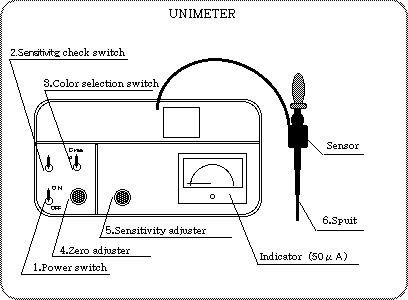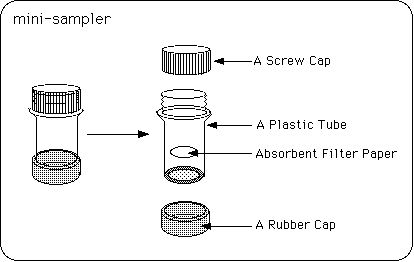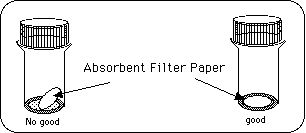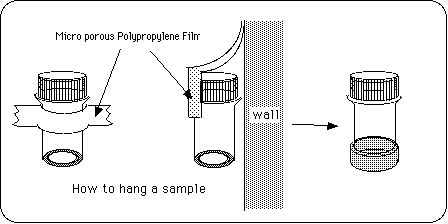![]()
Uni-Meters
and water pollutants by themselves (with attached instruments and reagents).
The spuit (pipet with bulb) type colorimeter indicates in analog or in digital the values ofconcentrations of
pollutants in solution, or values proportional to concentrations only by sucking thesolution into the spuit.
This is very convenient for analyzing a large number of samples quickly.
The test tuba type colorimeter with an attached light scattering meter indicates transmittance values.
Each of three LED, (Red, Green and Blue), is selected by a switch according to the color of solution tested.
The items measured by the Uni-Meter are as follows:
Water pollutants; NH4+, PO4-, total N,
NO2-, Anionic surfactants, COD, Cr+6,
Cl, Cu, Fe, As, etc.
Air pollutants; NO2, SO2, NH3, HCl, etc.
UNIMETER
Uni-Meter

Procedure of measurement
(1) Put on the power switch 1
(2) set the two way color selection switch 3 to the correct side.
Green color LED for reddish color solution and Red color LED for reddish color
solution. For NO2, set this switch 3 to Green color LED side.
(LED Light Emitting Diode Light source)
(3) Suck uncolored Saltzman solution into the spuit 6.
(Tap water can be used instead of Saltzman solution )
(4) Adjust the zero adjuster knob 4 to make the μ-ammeter indicate Zero
(5) Set the sensitivity check switch 2 up side.
(6) Adjust the sensitivity adjuster knob 5 to make the μ-ammeter indicate 50μA(full scale value).
(7) Set the sensitivity check switch 2 done side and repeat procedure (4)(5)(6) two
or three times until the indication stabilizes.
(8) Make calibration by using the standard solution of various concentrations.
(9) Then it is ready for use.
(10) In the course of measurement check "Zero'" by sucking colorless solution or water and
adjust zero with the zero adjuster knob 4.
sampler
mini-sampler
A " mini-sampler" is composed of an air tight plastic capsule with screw cap and porous polypropylene film at the bottom covered by a rubber cap and a piece of filter paper impregnated with absorbent reagent enclosed in it as shown in Fig.1.
Principle of measurement
The absorbent filter paper exposed in ambient air absorbs a particular air pollutant depending on the kind of absorbent reagent used. Quantity of the air pollutant collected in the absorbent filter paper is proportional to the product of concentration
of the air pollutant in ambient air and the exposure time interval. Quantity of the air pollutant collected in the absorbent filter paper is determined by a proper analytical method such as colorimetry or turbidimetry. From quantity of the pollutant collected in the sampler we can calculate average concentration of the pollutant over exposure time by using a value of collection coefficient of the sampler and exposure time. The porous polypropylene film can pass through molecules of air pollutant and works for eliminating wind effect on the collection coefficient of the sampler. By this device reliable data can be obtained.
The value of collection coefficient of the sampler is determined experimentally by comparing the quantity of a pollutant collected into the sampler with the value of average concentration of the pollutant measured by a standard method.

LET US MAKE A GLOBAL AIR POLLUTION MAP BY WORLD NGOS
This is your "mini-sampler" for preliminary measurement in your country in order to prepare for the global action of much larger scale simultaneous air pollution survey by world NGOs scheduled on the Earth Day next year 22nd April 1992.
Procedures of measurement
1) Take off the rubber cap and hang the sampler by adhesive tape putting it to a wall side, a pole or a tree at the place where you want to know air pollution. Do not lose the rubber cap! We need it later.
2) Make sure that the absorbent filter paper is placed flatly on the micro porous polypropylene film at the bottom of the sampler.* This is necessary to get reliable data.
3) After 24 hours, put on the rubber cap again and keep the sampler in clean atmosphere, such as in a refrigerator or a sealed bag.
4) After measurement, send your sampler as soon as possible to the following address together with a record paper writing the necessary items.

